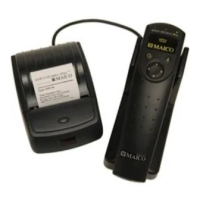
Do you have a question about the Maico Ero Scan Pro and is the answer not in the manual?
| OAE Type | DPOAE and TEOAE |
|---|---|
| Data Storage | Internal Memory |
| Power Source | Rechargeable Battery |
| Type | Otoacoustic Emissions Device |
| Stimulus | Clicks and Tones |
| Display | LCD |
| Connectivity | USB |
| Scan Modes | Screening, Diagnostic |
| Probe Frequency | Varies with test type |
Details the components of the ERO-SCAN Pro test instrument, including handheld unit, probes, printer, and accessories.
Lists standard and optional system parts included with the ERO-SCAN Pro, advising to save packaging.
Details how to install 4 AA/UM-3/R6 alkaline batteries into the ERO-SCAN Pro instrument.
Describes the power button, info button, navigator, and test status indicators on the instrument's control panel.
Explains the external probe keypads, left/right buttons, LEDs, and status indicators for probe detection and test progress.
Provides a five-step guide to begin testing with the ERO-SCAN Pro, including powering on and probe placement.
Details how to power on the ERO•SCAN Pro, including the initial flash screen and probe connection checks.
Guides on selecting the correct eartip size, ensuring a proper seal in the ear canal for accurate measurements.
Provides advice on ear canal examination, patient positioning, and explaining the painless nature of the test.
Explains how to use the lanyard (neck loop or shirt clip) to secure the external probe for testing.
Explains the AutoStart phase, its purpose in checking eartip seal, probe fit, and identifying issues like blockages or noise.
Explains how to navigate the selection menus after completing a single protocol or a series.
Explains the three OAE viewing options: DP/TE-Gram, Value Graph, and SNR Graph, and how to interpret them.
Details the DP/TE-Gram, Value Graph, and SNR Graph, including how to read signal, noise, and pass/fail indicators.
Explains how to interpret the tympanogram graph and the associated test details displayed on the instrument.
Illustrates abnormal tympanograms and discusses potential causes like perforations, flaccid membranes, or middle ear fluid.
Explains how to read the acoustic reflex display, including compliance changes, stimulus types, and overall test outcome (Pass/Refer).
Guides on how to access, view, and access details for saved test results stored within the instrument.
Details how to connect the ERO-SCAN Pro cradle to a computer using a USB cable for data transfer and customization.
Shows sample DPOAE and TEOAE printouts from the thermal paper printer, explaining header and data table content.
Explains how to select the instrument's display language from the Set Up menu.
Guides on how to set the instrument's time and date, including 12-hour and 24-hour clock options.
Explains how to view instrument details such as serial number, probe info, firmware version, and settings.
Describes the DP Early Stop feature, which stops DPOAE testing once criteria are met, potentially speeding up the process.
Details the Save Mode options, including 'No Patients' and 'Numbered Patients' for saving test results.
Explains how to enable or disable audible feedback to indicate test completion.
Describes the three options for viewing DPOAE test results: SNR graph, Value graph, and DP/TE-Gram.
Details how to restore the instrument to its manufacturer default settings via the Set Up menu.
Explains how to use the Print Results software to create and manage custom DPOAE, TEOAE, and Tympanometry protocols.
Describes how to modify existing protocols, noting that manufacturer defaults cannot be directly edited but can be copied.
Explains how to permanently delete protocol files from the computer directory.
Describes how to create a sequence of linked protocols (series) to streamline testing for a patient.
Describes creating test series, linking protocols, and their indication on the instrument menu.
Lists causes and resolutions for test failures during the AutoStart phase, such as probe fit or noise levels.
Addresses issues with instrument-computer communication, thermal printer not printing, and paper loading errors.
Provides guidelines for cleaning and disinfecting the instrument and its accessories safely, avoiding fluids and damage.
States that annual calibration by a distributor is required, with no other regular maintenance besides cleaning and battery replacement.
Details the procedure for replacing disposable probe tips, both internal and external, when they become clogged.
Lists critical precautions for using the device, including eartip use, battery handling, environmental conditions, and avoiding service.
Details specifications for primary tones, microphone system noise, artifact, and F1/F2 ratio for DPOAE measurements.
Details specifications for stimulus, click bandwidth, analysis bands, and artifact for TEOAE measurements.
Details specifications for stimulus, probe tone, stimulus intensity, and applicable standards for acoustic reflex measurements.
Provides contact information for assistance with the ERO-SCAN Pro, including phone and fax numbers for Maico Diagnostics.
Guides through the initial application installation process, including license agreement and folder selection.
Details how to customize printed report headers with text and logos using the PC software.
Guides on selecting the correct communication port for the cradle within the PC software's Communications settings.
Lists default screener protocols for DP, TE, and Combo tests, including included sub-protocols.
Lists default diagnostic protocols for DP, TE, and Combo tests, including included sub-protocols.
Lists default diagnostic protocols with ipsilateral reflex for DP, TE, and Combo tests.
Provides techniques for testing infants and young children, focusing on probe selection and patient handling.
Explains the complete test sequence: AutoStart, calibration, and test phase, including artifact rejection.
Describes the TEOAE test phase, including click stimulus, response measurement, and artifact rejection.
Explains the criteria for DPOAE Pass/Refer decisions based on signal-to-noise ratio (SNR) and amplitude.
Explains the criteria for TEOAE Pass/Refer decisions based on SNR and amplitude, noting lower SNR limits than DPOAEs.
Explains acoustic reflex Pass/Refer criteria based on compliance change and its relation to the tympanogram.
Discusses DPOAEs in healthy young ears (6-12 kHz) and provides examples comparing children and older adults.
Presents a table showing the number of tests required for reliable comparison between sessions at different confidence levels.
Discusses producing desired eardrum SPL at high frequencies, potential differences, and ERO•SCAN's approach.